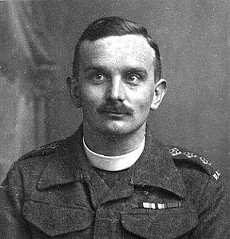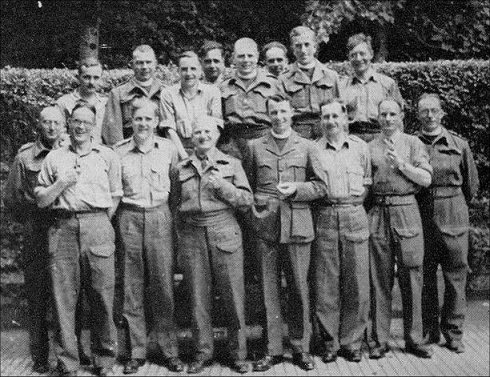Captain William Speirs (248378)
(Padre)
Rev. William Speirs was appointed as a chaplain to the British Army on the
30th October 1942 (4th Class Royal Army Chaplains’ Dept.). In Normandy he
was always close to the men in action. Major D. Y. Watson referred to his
actions at Hill 112 as follows; “The Padre, Capt. Speirs, who was most
popular with all ranks, had insisted on going with the advanced R.A.P. just
short of the crest, and there he did his usual good job of work—he was
almost a second M.O.”

Captain William Speirs
Bill recalls how he was wounded in the
later stages of the war:
My troubles began at Cleve in the Reichswald. I recall being there, being
‘stonked’ and taking refuge in a cemetery beside a skeleton and falling –
being blown over and collapsing into a ditch but wakening to find I had
twisted my knee. Doc Chalmers strapped me up and I hobbled around with a
stick, then for some reason, we chaplains were summoned to a conference (I
can’t remember where) and the Doc advised me to report to a hospital to get
the strapping replaced. The Surgeon, with many unkind references to my
mental stability, plastered me from ankle to hip, and deported me forthwith;
eventually I reached Queen Elizabeth Hospital in Birmingham and several
weeks later I got transferred to Edinburgh, having lost all my kit and even
identity for I got no vote at the elections and my mother-in-laws neighbour
reviled me over the fence for letting Mr. Churchill down!!
V.E Day I spent in bed; except that Mr. C. announced victory, said ‘We can
all go home! So I did but was recalled again with unkind words. I would have
done anything to rejoin the regiment but was eventually sent to Bulford in
Wiltshire (from which the good Lord preserve us) and so to Italy then in
post war chaos: but I had quite an interesting two years before demob.
In the Berrow’s Journal on
Saturaday the 3rd March 1945, Bill Speirs made this tribute to the courage
of the stretcher bearers:
“Though everybody else may be under cover they will go up and get the
wounded out. I should say that normally, within ten minutes of being hit a
man’s wounds are being dressed, and within half an hour he is on his way
back to the Divisional Hospital. That is due to the great courage of the
stretcher bearers. The infantryman will tell you that in his opinion every
stretcher bearer should have a medal.”

The Chaplains of the 43rd (Wessex) Division at Bayeux (28th July 1944)
Rev. William Speirs can be seen back row far left.